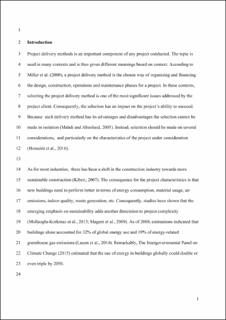| dc.contributor.author | Engebø, Atle | |
| dc.contributor.author | Klakegg, Ole Jonny | |
| dc.contributor.author | Lohne, Jardar | |
| dc.contributor.author | Lædre, Ola | |
| dc.date.accessioned | 2021-10-25T12:55:23Z | |
| dc.date.available | 2021-10-25T12:55:23Z | |
| dc.date.created | 2020-06-17T08:34:55Z | |
| dc.date.issued | 2020 | |
| dc.identifier.citation | International Journal of Managing Projects in Business. 2020, 13 (6), 1141-1165. | en_US |
| dc.identifier.issn | 1753-8378 | |
| dc.identifier.uri | https://hdl.handle.net/11250/2825412 | |
| dc.description.abstract | Purpose
To achieve the shift towards sustainable construction the industry must change the project delivery methods used. Therefore, this paper reports on a high-performance building project that implemented a collaborative project delivery method through the examination of the following research questions: RQ1: What were the most important contractual, cultural and organisational elements studied in the collaborative project delivery method? RQ2: What were the effects of the studied elements?
Design/methodology/approach
A longitudinal case study approach was adopted. As for means of data collection, a document review, semi-structured interviews, and observations was conducted. A total of 20 observations (App. 80 h, 175 pages of notes) and 12 interviews (App. 20 h, 100 pages of notes) with project participants was conducted.
Findings
The analysis indicates that if attention is paid to task, team and individual needs through contractual, cultural and organisational elements, this will affect the development of an integrated team.
Research limitations/implications
We demonstrate that the effects of the elements are shown through their achievement in creating and sustaining an integrated team of inter-organisational participants working in a collaborative environment.
Practical implications
It provides a better understanding of how a collaborative project delivery method for the design phase emphasises team integration. We demonstrate that while the principal sets the contractual boundaries by deciding the contractual elements, the agent should be intentional in the selection and use of organizational and cultural elements.
Originality/value
The paper suggests that it is not enough to just have contractual elements implemented. Consequently, this insight suggests that managers should be attentive to the untapped potential that lies within organisational and cultural elements. | en_US |
| dc.language.iso | eng | en_US |
| dc.publisher | Emerald | en_US |
| dc.title | A collaborative project delivery method for design of a high-performance building | en_US |
| dc.type | Journal article | en_US |
| dc.description.version | submittedVersion | en_US |
| dc.rights.holder | This is the manuscript to an article published by Emerald | en_US |
| dc.source.pagenumber | 1141-1165 | en_US |
| dc.source.volume | 13 | en_US |
| dc.source.journal | International Journal of Managing Projects in Business | en_US |
| dc.source.issue | 6 | en_US |
| dc.identifier.doi | 10.1108/IJMPB-01-2020-0014 | |
| dc.identifier.cristin | 1815870 | |
| dc.relation.project | Norges forskningsråd: 237859 | en_US |
| cristin.ispublished | true | |
| cristin.fulltext | preprint | |
| cristin.qualitycode | 1 | |
